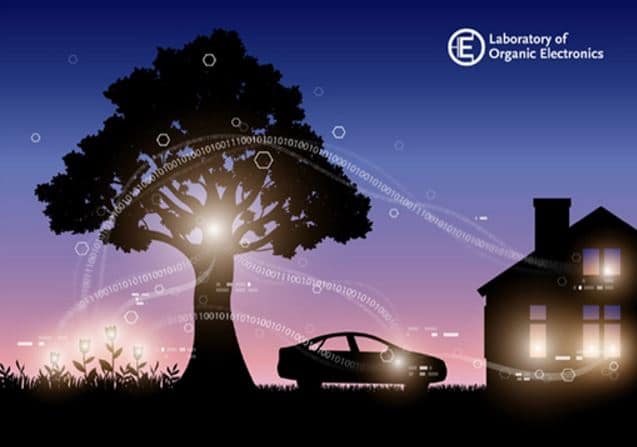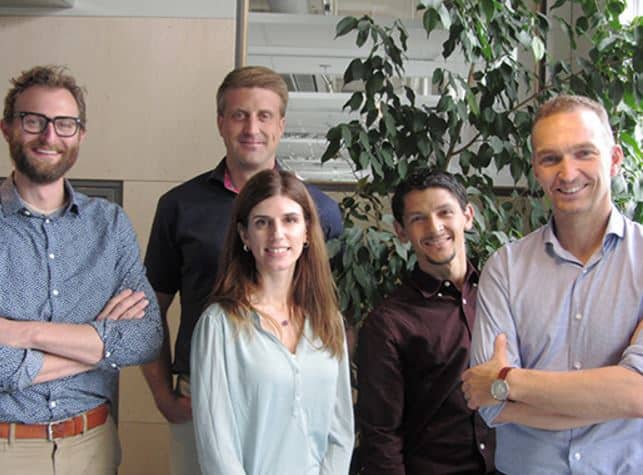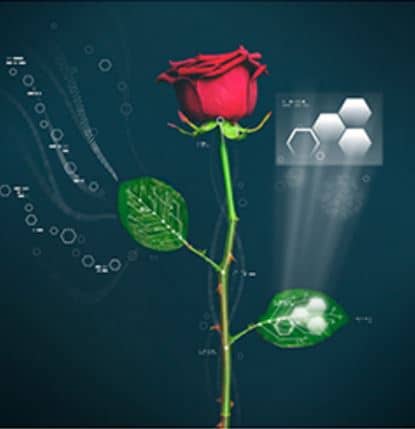Imagine a world where roses can produce electricity by harnessing photosynthesis to drive our cars, heat our homes, and move our industrial machines. This is what a team of Swedish researchers say is possible, after wiring up rose plants and using them like solar cells.
The scientists, from the Umeå Plant Science Center and Linköping University Laboratory for Organic Electronics, both in Sweden, explained in the journal Science that it is possible to create both analog and digital electronic circuits with trees, bushes and living flowers.
Team leader, Professor Magnus Berggren and colleagues said that with the help of channels that distribute water and nutrients in plants, they have built the key components of electronic circuits.
 A world where we could get plants to produce electricity, which would then drive our cars, heat our homes, and be an energy source for industry would be an amazing one. (Image: Linköping University)
A world where we could get plants to produce electricity, which would then drive our cars, heat our homes, and be an energy source for industry would be an amazing one. (Image: Linköping University)
Analog and digital electronic circuits in roses
They showed how roses can produce both analog and digital electronic circuits, which could eventually be used to, for instance, regulate the physiology of plants.
Traditional electronics send and process electronic signals, while plants transport and handle ions and growth hormones.
In organic electronics, based on semi-conductive polymers, both ions and electrons can serve as signal carriers. A polymer is a substance whose molecular structure is built up mainly or entirely from a large number of similar units bonded together.
With the help of organic electronics, it therefore becomes possible to combine the electric signals with that of plants’ – that is, translating the signals inside plants into traditional electronics.
Photosynthesis energy can be stored in fuel cells
A number of potential applications open with cheap organic electronics integrated into plants, such as reading or regulating how plants grow and function, or using the energy that comes from photosynthesis and storing it in a fuel cell.
 The research team at the Laboratory of Organic Electronics, starting from the left Daniel Simon, Roger Gabrielsson, Eleni Stavrinidou, Eliot Gomez and Magnus Berggren. Xavier Crispin is missing. (Image: Linköping University)
The research team at the Laboratory of Organic Electronics, starting from the left Daniel Simon, Roger Gabrielsson, Eleni Stavrinidou, Eliot Gomez and Magnus Berggren. Xavier Crispin is missing. (Image: Linköping University)
Ove Nilsson, professor of plant reproduction biology at the Umeå Plant Science Center, one of the article’s co-authors, said:
“Previously, we had no good tools for measuring the concentration of various molecules in living plants. Now we’ll be able to influence the concentration of the various substances in the plant that regulate growth and development. Here, I see great possibilities for learning more.”
Prof. Berggren has been studying printed electronic on paper for the past twenty-five years. He was particularly drawn by the idea of putting electronics into the plant itself, but never managed to get much interest from financial backers.
Everything changed for Prof. Berggren in 2012
In 2012, everything changed for Prof. Berggren, when the Knut and Alice Wallenberg Foundation backed his idea with hard cash. He immediately hired three researchers with new doctorates, Eleni Stavrinidou, Eliot Gomez and Roger Gabrielsson.
With the help of more senior scientists working at the Umeå Plant Science Center and Linköping University, their task was to determine whether it was possible to introduce and maybe even produce electronics in plants.
 The scientists wrote “With integrated and distributed electronics in plants, one can envisage a range of applications including precision recording and regulation of physiology, energy harvesting from photosynthesis, and alternatives to genetic modification for plant optimization.” (Image: Linköping University)
The scientists wrote “With integrated and distributed electronics in plants, one can envisage a range of applications including precision recording and regulation of physiology, energy harvesting from photosynthesis, and alternatives to genetic modification for plant optimization.” (Image: Linköping University)
The answer to that question soon became a resounding ‘Yes’. Within twenty-four months they managed to get plants to produce analog as well as digital circuits.
PEDOT-S, a water-soluble polymer, was discovered by Dr. Gabrielsson. When the polymer was absorbed by a rose, it was converted into a hydrogel which formed a thin membrane along the channel through which the plant absorbs nutrients and water.
Then, Dr. Stavrinidou, a postdoctoral scholar in the Laboratory of Organic Electronics of Linkoping University, got the plants to produce 10-cm segments, 50cm thick, of membranes of conductive polymer. A transistor was created by placing an electrode at each end with a gate in the middle.
A fully-functional transistor within a plant
Dr. Stavrinidou explained:
“We’ve produced the perfect measurement values, which show that it really is a fully functional transistor.”
Dr. Stavrinidou has measured the polymer’s conductive ability from 0.13 to 1 siemens/cm.
Dr. Gomez used vacuum infiltration – a method commonly used in plant biology – to send another PEDOT variant together with nanocellulose fibres into the rose’s foliage. The cellulose creates a 3-D structure with small cavities – just like a sponge – inside the rose leaf. The cavities are filled with the conductive polymer.
In this way, electrochemical cells are formed with several pixels, partitioned by the veins. The leaf’s fluid contains the electrolytes.
Dr. Gomez commented:
“We can create electrochromatic plants in which the leaves change color – it’s cool, but maybe not so useful.”
The plant solves what is seen as a weakness in organic electronics – the cold and wet – by encapsulating the polymer and thus protecting it from the elements.
Dr. Gabrielsson said:
“It seems as if the polymers we use had been created for their function.”
A new meaning for ‘Power Plants’
Professor Berggren said:
“Now we can really start talking about ‘power plants’ – we can place sensors in plants and use the energy formed in the chlorophyll, produce green antennas or produce new materials. Everything occurs naturally, and we use the plants’ own very advanced, unique systems.”
“As far as we know, there are no previously published research results regarding electronics produced in plants. No one’s done this before.”
Reference: “Electronic plants,” Ove Nilsson, Eleni Stavrinidou, Roger Gabrielsson, Eliot Gomez, Xavier Crispin, Daniel T. Simon and Magnus Berggren. Science Advances, Vol. 1, no. 10, e1501136. 20 November, 2015. DOI: 10.1126/sciadv.1501136.
